Elephantine papyri
The Elephantine Papyri consist of 175 documents from the Egyptian border fortresses of Elephantine and Aswan, which yielded hundreds of papyri in hieratic and demotic Egyptian, Aramaic, Koine Greek, Latin and Coptic, spanning a period of 100 years. The documents include letters and legal contracts from family and other archives, and are thus an invaluable source of knowledge for scholars of varied disciplines such as epistolography, law, society, religion, language and onomastics. They are a collection of ancient Jewish manuscripts dating from the 5th century BCE. They come from a Jewish community at Elephantine, then called ꜣbw. The dry soil of Upper Egypt preserved the documents.
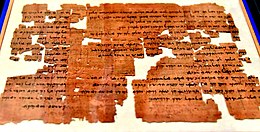
Hundreds of these Elephantine papyri span a period of 100 years. Legal documents and a cache of letters survived, turned up on the local "grey market" of antiquities starting in the late 19th century, and were scattered into several Western collections.
Though some fragments on papyrus are much older, the largest number of papyri are written in Aramaic, the lingua franca of the Achaemenid Empire, and document the Jewish community among soldiers stationed at Elephantine under Achaemenid rule, 495–399 BCE. The Elephantine documents include letters and legal contracts from family and other archives: divorce documents, the manumission of slaves, and other business, and are a valuable source of knowledge about law, society, religion, language and onomastics, the sometimes surprisingly revealing study of names.
The "Passover letter" of 419 BCE (discovered in 1907), which gives detailed instructions for properly observing the holiday of Passover is in the Egyptian Museum of Berlin.
Further Elephantine papyri are at the Brooklyn Museum. The discovery of the Brooklyn papyri is a remarkable story itself. The documents were first acquired in 1893 by New York journalist Charles Edwin Wilbour. After lying in a warehouse for more than 50 years, the papyri were shipped to the Egyptian Department of the Brooklyn Museum. It was at this time that scholars finally realized that "Wilbour had acquired the first Elephantine papyri".
Historical significance
The Elephantine papyri pre-date all extant manuscripts of the Hebrew Bible, and thus give scholars a very important glimpse at how Judaism was practiced in the fifth century BCE.[1] They show clear evidence of the existence in c. 400 BCE of a polytheistic sect of Jews, who seem to have had no knowledge of a written Torah or the narratives described therein:
So far as we learn from these texts Moses might never have existed, there might have been no bondage in Egypt, no exodus, no monarchy, no prophets. There is no mention of other tribes and no claim to any heritage in the land of Judah. Among the numerous names of colonists, Abraham, Jacob, Joseph, Moses, Samuel, David, so common in later times, never occur (nor in Nehemiah), nor any other name derived from their past history as recorded in the Pentateuch and early literature. It is almost incredible, but it is true.[2]
— Arthur Cowley, Aramaic Papyri of the Fifth Century B.C. pg. xxiii
Also important is the fact that the papyri document the existence of a small Jewish temple at Elephantine, which possessed altars for incense offerings and animal sacrifices, as late as 411 BCE. Such a temple would be in clear violation of Deuteronomic law, which stipulates that no Jewish temple may be constructed outside of Jerusalem.[1]:31 Furthermore, the papyri show that the Jews at Elephantine sent letters to the high priest in Jerusalem asking for his support in re-building their temple, which seems to suggest that the priests of the Jerusalem Temple were not enforcing Deuteronomic law at that time:
There is no hint of any suspicion that the [Elephantine] temple could be considered heretical, and they would surely not have appealed to the High Priest at Jerusalem if they had felt any doubt about it. On the contrary they give the impression of being proud of having a temple of their own, and as pious devotees of Ya'u Yahweh (no other god is mentioned in the petition) seriously distressed at the loss of religious opportunities caused by its destruction.[2]
— Arthur Cowley, Aramaic Papyri of the Fifth Century B.C. pg. xx
Upon first examination, this appears to contradict commonly accepted models of the development of Jewish religion and the dating of the Hebrew scriptures, which posit that monotheism and the Torah should have already been well-established by the time these papyri were written. Most scholars explain this apparent discrepancy by theorizing that the Elephantine Jews represented an isolated remnant of Jewish religious practices from earlier centuries,[1]:32 or that the Torah had only recently been promulgated at that time.[3]
Recently, however, scholars such as Niels Peter Lemche, Philippe Wajdenbaum, Russell Gmirkin, and Thomas L. Thompson have argued that the Elephantine papyri demonstrate that monotheism and the Torah could not have been established in Jewish culture before 400 BCE, and that the Torah was therefore likely written in the Hellenistic period, in the third or fourth centuries BCE.[4][1]:32ff
Jewish temple at Elephantine
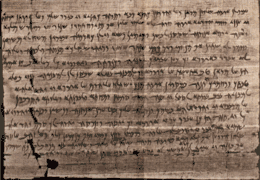
The Jews had their own temple to Yahweh[5] which functioned alongside that of the Egyptian god Khnum. Along with Yahweh, other deities – ʿAnat Betel and Asham Bethel – seem to have been worshiped by these Jews, evincing polytheistic beliefs.[6]
Excavation work done in 1967 revealed the remains of the Jewish colony centered on a small temple.[7]
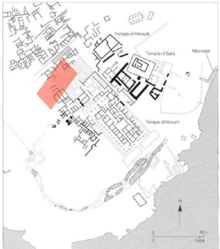
The "Petition to Bagoas" (Sayce-Cowley collection) is a letter written in 407 BCE to Bagoas, the Persian governor of Judea, appealing for assistance in rebuilding the Jewish temple in Elephantine, which had recently been badly damaged by an anti-Jewish rampage on the part of a segment of the Elephantine community.[8]
In the course of this appeal, the Jewish inhabitants of Elephantine speak of the antiquity of the damaged temple:
- Now our forefathers built this temple in the fortress of Elephantine back in the days of the kingdom of Egypt, and when Cambyses came to Egypt he found it built. They (the Persians) knocked down all the temples of the gods of Egypt, but no one did any damage to this temple.
The community also appealed for aid to Sanballat I, a Samaritan potentate, and his sons Delaiah and Shelemiah, as well as Johanan ben Eliashib. Both Sanballat and Johanan are mentioned in the Book of Nehemiah, 2:19, 12:23.[9]
There was a response of both governors (Bagoas and Delaiah) which gave the permission by decree to rebuild the temple written in the form of a memorandum: "1Memorandum of what Bagohi and Delaiah said 2to me, saying: Memorandum: You may say in Egypt ... 8to (re)build it on its site as it was formerly...".[10]
By the middle of the 4th century BCE, the temple at Elephantine had ceased to function. There is evidence from excavations that the rebuilding and enlargement of the Khnum temple under Nectanebo II (360–343) took the place of the former temple of YHWH.
In 2004, the Brooklyn Museum of Art created a display entitled "Jewish Life in Ancient Egypt: A Family Archive From the Nile Valley," which featured the interfaith couple of Ananiah, an official at the temple of Yahou (a.k.a. Yahweh), and his wife, Tamut, who was previously an Egyptian slave owned by a Jewish master, Meshullam.[11][12] Some related exhibition didactics of 2002 included comments about significant structural similarities between Judaism and the ancient Egyptian religion and how they easily coexisted and blended at Elephantine.[13]
Anat-Yahu
The papyri suggest that, "Even in exile and beyond, the veneration of a female deity endured."[14] The texts were written by a group of Jews living at Elephantine near the Nubian border, whose religion has been described as "nearly identical to Iron Age II Judahite religion".[15] The papyri describe the Jews as worshiping Anat-Yahu (mentioned in the document AP 44, line 3, in Cowley's numbering). Anat-Yahu is described as either the wife[16] (or paredra, sacred consort)[17] of Yahweh or as a hypostatized aspect of Yahweh.[15][18]
The family archive of Ananiah and Tamut
The eight papyri contained at the Brooklyn Museum concern one particular Jewish family, providing specific information about the daily lives of a man called Ananiah, a Jewish temple official; his wife, Tamut, an Egyptian slave; and their children, over the course of forty-seven years. Egyptian farmers discovered the archive of Ananiah and Tamut on Elephantine Island in 1893, while digging for fertilizer in the remains of ancient mud-brick houses. They found at least eight papyrus rolls which were purchased by Charles Edwin Wilbour. He was the first person to find Aramaic papyri. The papyri have been grouped here by topic, such as marriage contract, real estate transaction, or loan agreement.[19]
Marriage document
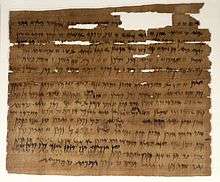
Ancient marriage documents generally formalized already existing relationships. In this case, Ananiah and Tamut already had a young son when the document was drawn up. Because Tamut was a slave when she married Ananiah, the contract has special conditions: usually, it was the groom and his father-in-law who made Jewish marriage agreements, but Ananiah made this contract with Tamut's master, Meshullam, who legally was her father. In addition, special provision was made to free the couple's son, also a slave to Meshullam; perhaps Ananiah consented to the small dowry of either 7 or 15 shekels (the text is ambiguous) in order to obtain his son's freedom. Future children, however, would still be born slaves. In contrast to Jewish documents like this one, contemporaneous Egyptian marriage documents were negotiated between a husband and wife.[20]
Deed of Emancipation
Nearly twenty-two years after her marriage to Ananiah, Tamut's master released her and her daughter, Yehoishema, from slavery. It was rare for a slave to be freed. And though a slave could marry a free person, their children usually belonged to the master. As an institution, slavery in Egypt at that time differed in notable ways from the practice in some other cultures: Egyptian slaves retained control over personal property, had professions, and were entitled to compensation. During the Persian Period in Egypt, it was not uncommon to sell children, or even oneself, into slavery to pay debts.
Real estate documents
Bagazust and Ubil sell a house to Ananiah
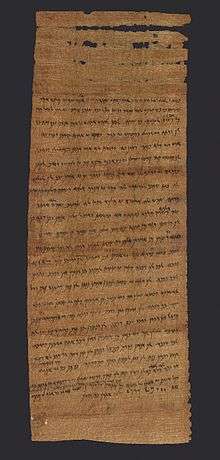
This document to the right describes a property purchased by Ananiah, twelve years after his marriage, from a Persian soldier named Bagazust and his wife, Ubil. The property, in a town on Elephantine Island, named for the god Khnum, was located across the street from the Temple of Yahou and adjacent to the Persian family of Ubil's Father. As such proximity might suggest, the Egyptians, Jews, and Persians in Elephantine all lived among one another. The renovation of the house and its gradual transfers to family members are the central concerns of the next several documents in Ananiah's family archive.[21]
Ananiah gives Tamut part of the house
Three years after purchasing the house from Bagazust and Ubil, Ananiah transferred ownership of an apartment within the now renovated house to his wife, Tamut. Although Tamut thereafter owned the apartment, Ananiah required that at her death it pass to their children, Palti and Yehoishema. As with all property transfers within a family, this gift was described as made "in love". Image of document in gallery.[22]
Ananiah gives Yehoishema part of the house
Drawn up thirty years after the preceding papyrus, this document is one of several that gradually transferred ownership of Ananiah and Tamut's house to their daughter, Yehoishema, as payment on her dowry. The legal descriptions of the house preserve the names of Ananiah's neighbors. They included an Egyptian who held the post of gardener of the Egyptian god Khnum and, on the other side, two Persian boatmen. Image of document in gallery.[23]
Ananiah gives Yehoishema another part of the house
For his daughter Yehoishema's dowry, Ananiah had transferred to her partial ownership of the house he shared with Tamut. After making more repairs to the building, Ananiah transferred a further section of the house, described in this document, to the dowry. Image of document in gallery.[24]
Ananiah and Tamut sell the house to their son-in-law
This papyrus records the sale of the remaining portion of Ananiah and Tamut's house to Yehoishema's husband. Possibly because the clients were dissatisfied with something the scribe had written, at one point the text of the document breaks off and then starts over again, repeating what has gone on before with some additions. The boundary description included here refers to the Temple of Yahou in Elephantine, now rebuilt eight years after its destruction in 410 BCE during a civil war conflict that arose out of a land dispute. Image of document in gallery below.[25]
Loan agreement
Sometime in December 402 BCE, Ananiah son of Haggai borrowed two monthly rations of grain from Pakhnum son of Besa, an Aramean with an Egyptian name. This receipt would have been held by Pakhnum and returned to Ananiah son of Haggai when he repaid the loan. No interest is charged but there is a penalty for failing to repay the loan by the agreed date. The receipt demonstrates that friendly business relations continued between Egyptians and Jews in Elephantine after the expulsion of the Persians by Amyrtaeus, the only pharaoh of the Twenty-eighth Dynasty of Egypt. Image of document is in gallery below.[26]
Gallery
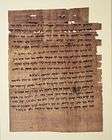 Freedom for Tamut and Yehoishema, June 12, 427 BCE, Brooklyn Museum
Freedom for Tamut and Yehoishema, June 12, 427 BCE, Brooklyn Museum Ananiah Gives Tamut Part of the House, October 30, 434 BCE, Brooklyn Museum
Ananiah Gives Tamut Part of the House, October 30, 434 BCE, Brooklyn Museum Ananiah Gives Yehoishema Part of the House, November 26, 404 BCE, Brooklyn Museum
Ananiah Gives Yehoishema Part of the House, November 26, 404 BCE, Brooklyn Museum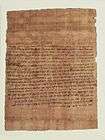 Ananiah Gives Yehoishema Another Part of the House, March 10, 402 BCE, Brooklyn Museum
Ananiah Gives Yehoishema Another Part of the House, March 10, 402 BCE, Brooklyn Museum House Sale, December 12, 402 BCE, Brooklyn Museum
House Sale, December 12, 402 BCE, Brooklyn Museum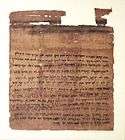 Receipt for a Grain Loan, December 402 BCE, Brooklyn Museum
Receipt for a Grain Loan, December 402 BCE, Brooklyn Museum
References
- Gmirkin, Russell (2006). Berossus and Genesis, Manetho and Exodus: Hellenistic Histories and the Date of the Pentateuch. New York: T & T Clark International. pp. 29ff. ISBN 0-567-02592-6.
- Cowley, Arthur (2005). Aramaic Papyri of the Fifth Century B.C. Eugene, OR: Wipf & Stock Publishers. pp. xx–xxiii. ISBN 1-59752-3631.
- Greifenhagen, Franz V. (2003). Egypt on the Pentateuch's Ideological Map. Bloomsbury. pp. 236–245. ISBN 978-0-567-39136-0.
- Wajdenbaum, Philippe (2016). "From Plato to Moses: Genesis-Kings as a Platonic Epic". In Hjelm, Ingrid; Thompson, Thomas L. (eds.). Biblical Interpretation Beyond Historicity. Changing Perspectives. 7. New York: Routledge. pp. 76–90. ISBN 978-1-315-69077-3.
- The written form of the Tetragrammaton in Elephantine is YHW.
- Paolo Sacchi, The History of the Second Temple Period. T&T Clark International, 2000, London/New York, p.151
- Stephen Gabriel Rosenberg (1 July 2013). "Was there a Jewish temple in ancient Egypt?". The Jerusalem Post. Retrieved 3 December 2015.
- Comment on 'Petition to Bagoas' (Elephantine Papyri), by Jim Reilly in his book Nebuchadnezzar & the Egyptian Exile Archived 2011-07-23 at the Wayback Machine From website www.kent.net. Retrieved 18 July 2010.
- Merrill Unger, Unger's Bible Handbook, p.260
- Bezalel Porten; Ada Yardeni, Textbook of Aramaic Documents from Ancient Egypt 1. Jerusalem 1986, Letters, 76 (=TADAE A4.9)
- New Tales From a Post-Exodus Egypt by Naomi Pfefferman, 2004-04-08, Jewish Journal
- So long ago, so very much like us: A multicultural couple marries, buys a house, raises kids. That's the age-old story of 'Jewish Life in Ancient Egypt' at the Skirball 2004-05-11, Los Angeles Times
- Jewish Life in Ancient Egypt See esp. section "Jewish and Egyptian Ritual in Elephantine" and other sections. 2002
- Gnuse, Robert Karl (1997). No Other Gods: Emergent Monotheism in Israel. T&T Clark. p. 185. ISBN 978-1850756576.
- Noll, K.L. (January 2001). Canaan and Israel in Antiquity: An Introduction. 2001: Sheffield Academic Press. p. 248. ISBN 9781841273181.CS1 maint: location (link)
- Day, John (2002). Yahweh and the Gods and Goddesses of Canaan. 143: Sheffield Academic Press. ISBN 978-0826468307.CS1 maint: location (link)
- Edelman, Diana Vikander (1996). The triumph of Elohim: from Yahwisms to Judaisms. William B. Eerdmans. p. 58. ISBN 978-0802841612.
- Susan Ackerman (2004). "Goddesses". In Suzanne Richard (ed.). Near Eastern Archaeology: A Reader. Eisenbrauns. p. 394. ISBN 978-1575060835.
- Bleiberg, Edward (2002). Jewish Life in Ancient Egypt: A Family Archive from the Nile Valley. Brooklyn, NY: Booklyn Museum of Art.
- Bleiberg, Edward (2002). Jewish Life in Ancient Egypt: A Family Archive from the Nile Valley. Brooklyn, NY: Brooklyn Museum of Art. p. 26.
- Bleiberg, Edward (2002). Jewish Life in Ancient Egypt: A Family Archive from the Nile Valley. Brooklyn, NY: Brooklyn Museum of Art. p. 30.
- Bleiberg, Edward (2002). Jewish Life in Ancient Egypt: A Family Archive from the Nile Valley. Brooklyn, NY: Brooklyn Museum of Art. p. 32.
- Bleiberg, Edward (2002). Jewish Life in Ancient Egypt: A Family Archive from the Nile Valley. Brooklyn, NY: Brooklyn Museum of Art. p. 34.
- Bleiberg, Edward (2002). Jewish Life in Ancient Egypt: A Family Archive from the Nile Valley. Brooklyn, NY: Brooklyn Museum of Art. p. 36.
- Bleiberg, Edward (2002). Jewish Life in Ancient Egypt: A Family Archive from the Nile Valley. Brooklyn, NY: Brooklyn Museum of Art. p. 39.
- Bleiberg, Edward; Brooklyn Museum of Art (2002). Jewish life in ancient Egypt: a family archive from the Nile Valley. Brooklyn Museum of Art. p. 23.
Further reading
- Bresciani, Edda (1998). "ELEPHANTINE". Encyclopaedia Iranica, Vol. VIII, Fasc. 4. pp. 360–362.CS1 maint: ref=harv (link)
- Cowley, Arthur, The Aramaic Papyri of the Fifth Century, 1923, Oxford: The Clarendon Press.
- Emil G. Kraeling, The Brooklyn Museum Aramaic Papyri, 1953, Yale University Press.
- Bezalel Porten, with J.J. Farber, C.J. Martin, G. Vittman, editors. 1996. The Elephantine Papyri in English: Three Millennia of Cross-Cultural Continuity and Change, (Brill Academic)
- Bezalel Porten, Archives from Elephantine: The Life of an Ancient Jewish Military Colony, 1968. (Berkeley: University of California Press)
- Yochanan Muffs (Prolegomenon by Baruch A. Levine), 2003. Studies in the Aramaic Legal Papyri from Elephantine (Brill Academic)
- A. van Hoonacker, Une Communauté Judéo-Araméenne à Éléphantine, en Égypte aux VIe et Ve siècles av. J.-C., 1915, London, The Schweich Lectures
- Joseph Mélèze-Modrzejewski, The Jews of Egypt, 1995, Jewish Publication Society
External links
| Wikimedia Commons has media related to Elephantine papyri. |
- The Elephantine papyri in English: Three Millennia of Cross-Cultural Continuity and Change. Bezalel Porten e.a.. Brill, Leiden, The Netherlands, 1996. Retrieved 18 July 2010.
- Introduction and text of the 'Passover Papyrus' contained in the Elephantine papyri. (from the Internet Archive because original site was deleted)
- A Passover Letter.
- P.Eleph.: Aegyptische Urkunden aus den königlichen Museen in Berlin
- P.Eleph.Wagner: Elephantine XIII: Les papyrus et les ostraca grecs d'Elephantine
- COJS: The Elephantine Temple, 407 BCE